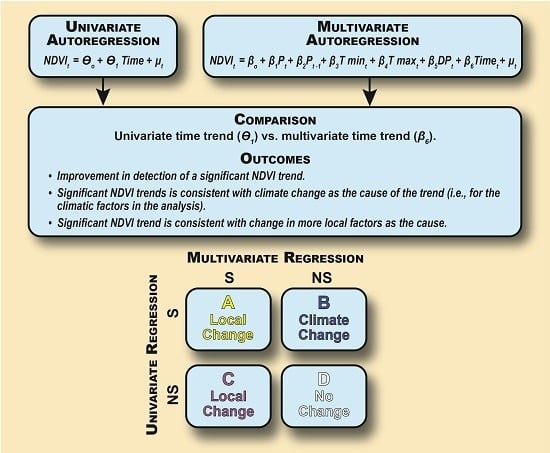Changes in Landscape Greenness and Climatic Factors over 25 Years (1989–2013) in the USA
Abstract
:1. Introduction
2. Materials and Methods
2.1. Data
2.2. Statistical Methods
2.2.1. Univariate Autoregression
2.2.2. Multivariate Autoregression
2.2.3. Comparison of Univariate and Multivariate Models
- NDVI trend was significant in both the univariate and multivariate analyses. NDVI significance apparently resulted from direct factors such as wildfire or agriculture, because the trend was significant regardless of whether climatic factors were included in the analysis.
- NDVI trend was significant in the univariate analysis, but not in the multivariate analysis. This is consistent with a change in the climatic factors as the cause of the significant NDVI trend.
- NDVI trend was not significant in the univariate analysis, but was significant in the multivariate analysis. A significant trend in the multivariate analysis would suggest that the change is presumably due to direct factors. However, the trend in the univariate analysis might not be significant because the variation in NDVI associated indirectly with variation in climatic factors was masked by the influence of direct factors on NDVI.
- NDVI trend was not significant in either the univariate or the multivariate analyses. This would suggest that there is no evidence for a temporal trend in NDVI.
3. Results of Univariate and Multivariate Models
3.1. Univariate Autoregression Results
3.2. Association between the NDVI and Climatic Factors in Multivariate Analyses
3.3. NDVI Trend in Multivariate Analyses
4. Discussion
5. Evaluation of Selected Areas for Cause of NDVI Change
5.1. Flooding of Agricultural Areas
5.2. Fires and Post Fire Greenness Gains
5.3. Tree Mortality Due to Insect Infestation
5.4. Change Attributable to Climate
5.5. Comparison with Previous Studies
6. Conclusions
Supplementary Materials
Acknowledgments
Author Contributions
Conflicts of Interest
References
- Tucker, C.J. Red and Photographic Infrared Linear Combinations for Monitoring Vegetation. Remote Sens. Environ. 1979, 8, 127–150. [Google Scholar] [CrossRef]
- Minor, T.B.; Lancaster, J.; Wade, T.G.; Wickham, J.D.; Whitford, W.; Jones, K.B. Evaluation changes in rangeland condition using multitemporal AVHRR data and geographic information system analysis. Environ. Monit. Assess. 1999, 59, 211–233. [Google Scholar] [CrossRef]
- Lanfredi, M.; Lasaponara, R.; Simoniello, T.; Cuomo, V.; Macchiato, M. Multiresolution spatial characterization of land degradation phenomena in southern Italy from 1985 to 1999 using NOAA-AVHRR NDVI data. Geophys. Res. Lett. 2003, 30. [Google Scholar] [CrossRef]
- Gurgel, H.C.; Ferreira, N.J. Annual and international variability of NDVI in Brazil and its connections with climate. Int. J. Remote Sens. 2003, 24, 3595–3609. [Google Scholar] [CrossRef]
- Nash, M.S.; Wade, T.; Heggem, D.T.; Wickham, J. Does Anthropogenic Activities or Nature Dominate the Shaping of the Landscape in the Oregon Pilot Study Area for 1990–1999? In Desertification in the Mediterranean Region: A Security Issue; NATO Science for Peace and Security Series C: Environmental Security; Kepner, W.G., Rubio, J.L., Mouat, D.A., Pedrazzini, F., Eds.; Springer: Dordrecht, The Netherlands, 2006; Volume 3, pp. 305–323. [Google Scholar]
- Vogelmann, J.E.; Tolk, B.; Zhu, Z. Monitoring forest changes in the southwestern United States using multitemporal Landsat data. Remote Sens. Environ. 2009, 113, 1739–1748. [Google Scholar] [CrossRef]
- Rigge, M.; Wylie, B.; Gu, Y.; Belnap, J.; Phuyal, K.; Tieszen, L. Monitoring the status of forests and rangelands in the western United States using ecosystem performance anomalies. Int. J. Remote Sens. 2013, 34, 4049–4068. [Google Scholar] [CrossRef]
- Nash, M.S.; Bradford, D.F.; Wickham, J.D.; Wade, T.G. Detecting Change in Landscape Greenness over Large Areas: An Example for New Mexico, USA. Remote Sens. Environ. 2014, 150, 152–162. [Google Scholar] [CrossRef]
- Eidenshink, J.C. The 1990 conterminous U.S. AVHRR data set. Photogramm. Eng. Remote Sens. 1992, 58, 809–813. [Google Scholar]
- Wang, J.; Rich, P.M.; Price, K.P. Temporal response of NDVI to precipitation and temperature in the central great plains, USA. Int. J. Remote Sens. 2003, 24, 2345–2364. [Google Scholar] [CrossRef]
- Twumasi, Y.A.; Coleman, T.L.; Manu, A.; Merem, E.C.; Osei, A. Relationship between climate parameters and forest vegetation at and near Digya National Park, Ghana. Br. J. Environ. Clim. Chang. 2011, 1, 201–215. [Google Scholar] [CrossRef] [PubMed]
- Reed, B.C. Trend analysis of time-series phenology of North America derived from satellite data. GISci. Remote Sens. 2006, 43, 24–38. [Google Scholar] [CrossRef]
- Jones, K.B.; Hamann, S.; Nash, M.S.; Neale, A.C.; Kepner, W.G.; Wade, T.G.; Walker, J.; Müller, F.; Zurlini, G.; Zaccarelli, N.; et al. Cross-European Landscape Analyses: Illustrative Examples Using Existing Spatial Data. In Use of Landscape Sciences for the Assessment of Environmental Security; NATO Science for Peace and Security Series C: Environmental Security; Petrosillo, I., Müller, F., Jones, K.B., Zurlini, G., Krauze, K., Victrove, S., Li, B.L., Kepner, W.G., Eds.; Springer: Dordrecht, The Netherlands, 2008; pp. 263–316. [Google Scholar]
- Nash, M.S.; Chaloud, D.J.; Kepner, W.G.; Sarri, S. Regional Assessment of Landscape and Land Use Change in the Mediterranean Region: Morocco Case Study (1981–2003). In Environmental Change and Human Security: Recognizing and Acting on Hazard Impacts; NATO Science for Peace and Security Series C: Environmental Security; Liotta, P.H., Mouat, D., Kepner, W.G., Lancaster, J.M., Eds.; Springer: Dordrecht, The Netherlands, 2008; pp. 143–165. [Google Scholar]
- Anyamba, A.; Tucker, C. Analysis of Sahelian vegetation dynamics using NOAA-AVHRR NDVI data from 1981–2003. J. Arid Environ. 2005, 63, 596–614. [Google Scholar] [CrossRef]
- Kawabata, A.; Ichii, K.; Yamaguchi, Y. Global monitoring of interannual changes in vegetation activities using NDVI and its relationships to temperature and precipitation. Int. J. Remote Sens. 2001, 22, 1377–1382. [Google Scholar] [CrossRef]
- Sobrino, J.A.; Julien, Y. Global trends in NDVI-derived parameters obtained from GIMMS data. Int. J. Remote Sens. 2011, 32, 4267–4279. [Google Scholar] [CrossRef]
- Van Mantgem, P.J.; Stephenson, N.L.; Byrne, J.C.; Daniels, L.D.; Franklin, J.F.; Fulé, P.Z.; Harmon, M.E.; Larson, A.J.; Smith, J.M.; Taylor, A.H.; et al. Widespread Increase of Tree Mortality Rates in the Western United States. Science 2009, 323, 521–524. [Google Scholar] [CrossRef] [PubMed]
- Vogelmann, J.E.; Xian, G.; Homer, C.; Tolk, B. Monitoring gradual ecosystem change using Landsat time series analyses: Case studies in selected forest and rangeland ecosystems. Remote Sens. Environ. 2012, 122, 92–105. [Google Scholar] [CrossRef]
- Allen, C.D.; Breshears, D.D. Drought-induced shift of forest-woodland ecotone: rapid landscape response to climate variation. Proc. Natl. Acad. Sci. USA 1998, 95, 14839–14842. [Google Scholar] [CrossRef] [PubMed]
- Pettorelli, N.; Pelletier, F.; von Hardenberg, A.; Festa-Bianchet, M.; Cote, S.D. Early onset of vegetation growth vs. rapid green-up impact on juvenile mountain ungulates. Ecology 2007, 88, 381–390. [Google Scholar] [CrossRef] [PubMed]
- Potapov, P.V.; Dempewolf, J.; Talero, Y.; Hansen, M.C.; Stehman, S.V.; Vargas, C.; Rojas, S.V.; Castillo, D.; Mendoza, E.; Calderón, A.; et al. National satellite-based humid tropical forest change assessment in Peru in support of REDD+ implementation. Environ. Res. Lett. 2014, 9, 13. [Google Scholar] [CrossRef]
- Bounoua, L.; Collatz, G.J.; Sellers, P.J.; Randall, D.A.; Dazlich, D.A.; Los, S.O.; Berry, J.A.; Fung, I.; Tucker, C.J.; Field, C.B.; et al. Interactions between vegetation and climate: Radiative and physiological effects of doubled atmospheric CO2. J. Clim. 1999, 12, 309–324. [Google Scholar] [CrossRef]
- Rosenzweig, C.G.; Casassa, D.J.; Karoly, A.; Imeson, A.; Liu, C.; Menzel, A.; Rawlins, S.; Root, T.L.; Seguin, B.; Tryjanowski, P. Assessment of Observed Changes and Responses in Natural and Managed Systems. Climate Change 2007: Impacts, Adaptation and Vulnerability. In Contribution of Working Group II to the Fourth Assessment Report of the Intergovernmental Panel on Climate Change; Parry, M.L., Canziani, O.F., Palutikof, J.P., van der Linden, P.J., Hanson, C.E., Eds.; Cambridge University Press: Cambridge, UK, 2007; pp. 79–131. [Google Scholar]
- Malo, A.R.; Nicholson, S.E. A study of rainfall and vegetation dynamics in the African Sahel using normalized difference vegetation index. J. Arid Environ. 1990, 19, 1–24. [Google Scholar]
- Azzali, S.; Menenti, M. Mapping vegetation-soil-climate complexes in southern Africa using temporal Fourier of NOAA-AVHRR NDVI data. Int. J. Remote Sens. 2000, 21, 973–996. [Google Scholar] [CrossRef]
- Wessels, K.J.; Prince, S.D.; Carroll, M.; Malherbe, J. Relevance of rangeland degradation in semiarid northeaster South Africa to the nonequilibrium theory. Ecol. Appl. 2007, 17, 815–827. [Google Scholar] [CrossRef] [PubMed]
- Lybbert, T.J.; Aboudrare, A.; Chaloud, D.J.; Magnan, N.; Nash, M.S. Booming Markets for Moroccan argan oil appear to benefit some rural households while threatening the endemic argan forest. Proc. Natl. Acad. Sci. USA 2011, 108, 13963–13968. [Google Scholar] [CrossRef] [PubMed]
- Sonfack, R.; Nzeukou, A.; Lenouo, A.; Siddi, T.; Tchakoutio, S.A.; Kaptue, A. Comparison between vegetation and rainfall of bioclimatic ecoregions in central Africa. Atmosphere 2013, 4, 411–427. [Google Scholar]
- U.S. Global Change Research Program, 2009. Global Climate Change Impact in the United States, 2009 Report. Available online: https://nca2009.globalchange.gov/ (accessed on 20 March 2017).
- Fernández-Manso, A.; Quintano, C.; Fernández-Manso, O. Forecast of NDVI in coniferous areas using temporal ARIMA analysis and climatic data at a regional scale. Int. J. Remote Sens. 2011, 32, 1595–1617. [Google Scholar] [CrossRef]
- Chamaillé-Jammes, S.; Fritz, H. Precipitation-NDVI relationships in eastern and southern African savannas vary along a precipitation gradient. Int. J. Remote Sens. 2009, 30, 3409–3422. [Google Scholar] [CrossRef]
- Ding, M.; Zhang, Y.; Liu, L.; Zhang, W.; Wang, Z.; Bai, W. The relationship between NDVI and precipitation on the Tibetan plateau. J. Geogr. Sci. 2007, 17, 259–268. [Google Scholar] [CrossRef]
- Duan, H.; Yan, C.; Tsunekawa, A.; Song, X.; Li, S.; Xie, J. Assessing vegetation dynamics in the Three-North Shelter Forest region of China using AVHRR NDVI data. Environ. Earth Sci. 2011, 64, 1011–1020. [Google Scholar] [CrossRef]
- Erasmi, S.; Maurer, F.; Petta, R.A.; Gerold, G.; Barbosa, M.P. Inter-annual variability of the normalized difference vegetation index over northeast Brazil and its relation to rainfall and El Nino southern oscillation. Geo Öko 2009, 30, 185–206. [Google Scholar]
- Fensholt, R.; Langanke, T.; Rasmussen, K.; Reenberg, A.; Prince, S.D.; Tucker, C.; Scholes, R.J.; Le, Q.B.; Bondeau, A.; Eastman, R.; et al. Greenness in semi-arid areas across the globe 1981–2007—An earth observing satellite based analysis of trends and drivers. Remote Sens. Environ. 2012, 121, 144–158. [Google Scholar] [CrossRef]
- Herrmann, S.M.; Anyamba, A.; Tucker, C.J. Recent trends in vegetation dynamics in the African Sahel and their relationship to climate. Glob. Chang. Biol. 2005, 15, 394–404. [Google Scholar] [CrossRef]
- Ichii, K.; Kawabata, A.; Yamaguchi, Y. Global correlation analysis for NDVI and climatic variables and NDVI trends: 1982–1990. Int. J. Remote Sens. 2002, 23, 3873–3878. [Google Scholar] [CrossRef]
- Ji, L.; Peters, J. A spatial regression procedure for evaluating the relationship between AVHRR-NDVI and climate in the northern Great Plains. Int. J. Remote Sens. 2004, 25, 297–311. [Google Scholar] [CrossRef]
- Karnieli, A.; Agam, M.; Pinker, R.T.; Anderson, M.; Imhoff, M.L.; Gutman, G.G.; Panov, N.; Goldberg, A. Use of NDVI and land surface temperature for drought assessments: Merits and limitations. J. Clim. 2010, 23, 618–633. [Google Scholar] [CrossRef]
- Li, Z.; Guo, X. Detecting climate effects on vegetation in northern mixed prairie using NOAA AVHRR 1-km time-series NDVI data. Remote Sens. 2012, 4, 120–134. [Google Scholar] [CrossRef]
- Mao, D.; Wang, Z.; Luo, L.; Ren, C. Integrating AVHRR and MODIS data to monitor NDVI changes and their relationships with climatic parameters in northeast China. Int. J. Appl. Earth Obs. Geoinf. 2012, 18, 528–536. [Google Scholar] [CrossRef]
- Neeti, N.; Rogan, J.; Christman, Z.; Eastman, J.R.; Millones, M.; Scheider, L.; Nickl, E.; Schmook, B.; Turner, B.L., II; Ghimire, B. Mapping seasonal trends in vegetation using AVHRR-NDVI time series in the Yucatán peninsula, Mexico. Remote Sens. Lett. 2011, 3, 433–442. [Google Scholar] [CrossRef]
- Olsson, L.; Eklund, L.; Ardö, J. A recent greening of the Sahel—Trends, patterns and potential causes. J. Arid Environ. 2005, 63, 556–566. [Google Scholar] [CrossRef]
- Park, H.S.; Sohn, B.J. Recent trends in changes of vegetation over East Asia coupled with temperature and rainfall variations. J. Geophys. Res. 2010, 115, D14101. [Google Scholar] [CrossRef]
- Peng, S.; Chen, A.; Xu, L.; Cao, C.; Fang, J.; Myneni, R.B.; Pinson, J.E.; Tucker, C.J.; Piao, S. Recent vegetation growth trend in China. Environ. Res. Lett. 2011, 6, 1–13. [Google Scholar] [CrossRef]
- Pouliot, D.; Latifovic, R.; Olthof, I. Trends in vegetation NDVI from 1 km AVHRR data over Canada for the period 1985–2006. Int. J. Remote Sens. 2009, 30, 149–168. [Google Scholar] [CrossRef]
- Weiss, J.L.; Gutzler, D.S.; Coonrod, J.E.A.; Dahm, C.L. Long-term vegetation monitoring with NDVI in a diverse semi-arid setting, central New Mexico, USA. J. Arid Environ. 2004, 58, 249–272. [Google Scholar] [CrossRef]
- Zhang, X.; Goldberg, M.; Tarpley, D.; Friedl, M.A.; Morisette, J.; Kogan, F.; Yu, Y. Drought-induced vegetation stress in southwestern North America. Environ. Res. Lett. 2010, 5, 1–11. [Google Scholar] [CrossRef]
- Zoffoli, M.L.; Kandus, P.; Madanes, N.; Calvo, D.H. Seasonal and interannual analysis of wetlands in South America using NOAA-AVHRR NDVI time series: The case of the Parana Delta region. Landsc. Ecol. 2008, 23, 833–848. [Google Scholar] [CrossRef]
- Beck, H.E.; McVicar, T.R.; van Dijk, A.I.J.M.; Schellekens, J.; de Jeu, R.A.M.; Bruijnzeel, L.A. Global evaluation of four AVHRR-NDVI data sets: Intercomparison and assessment against Landsat imagery. Remote Sens. Environ. 2011, 115, 2547–2563. [Google Scholar] [CrossRef]
- Ji, L.; Peters, A.J. Assessing vegetation response to drought in the northern Great Plains using vegetation and drought indices. Remote Sens. Environ. 2003, 87, 85–98. [Google Scholar] [CrossRef]
- Van Oldenborgh, G.J.; Collins, M.; Arblaster, J.; Christensen, J.H.; Marotzke, J.; Power, S.B.; Rummukainen, M.; Zhou, T. IPCC, 2013: Annex I: Atlas of Global and Regional Climate Projections. In Climate Change 2013: The Physical Science Basis. Contribution of Working Group I to the Fifth Assessment Report of the Intergovernmental Panel on Climate Change; Stocker, T.F., Qin, D., Plattner, G.-K., Tignor, M., Allen, S.K., Boschung, J., Nauels, A., Xia, Y., Bex, V., Midgley, P.M., Eds.; Cambridge University Press: Cambridge, UK; New York, NY, USA, 2013. [Google Scholar]
- Loarie, S.R.; Duffy, P.B.; Hamilton, H.; Asner, G.P.; Field, C.B.; Ackerly, D.D. The velocity of climate change. Nature 2009, 262, 1052–1054. [Google Scholar] [CrossRef] [PubMed]
- Loveland, T.R.; Sohl, T.L.; Stehman, S.V.; Gallant, A.L.; Sayler, K.L.; Napton, D.E. A strategy for estimating the rates of recent United States land-cover changes. Photogramm. Eng. Remote Sens. 2002, 68, 1091–1099. [Google Scholar]
- Eidenshink, J. A 16-year time series of 1 km AVHRR satellite data of the conterminous United States and Alaska. Photogramm. Eng. Remote Sens. 2006, 72, 1027–1035. [Google Scholar] [CrossRef]
- Holben, B.N. Characteristics of maximum value composite images from temporal AVHRR data. Int. J. Remote Sens. 1986, 7, 1417–1434. [Google Scholar] [CrossRef]
- Stowe, L.L.; Davis, P.A.; McClain, P.E. Scientific basis and initial evaluation of the CLAVR-1 global clear/cloud classification algorithm for the advanced very resolution radiometer. J. Atmos. Ocean Technol. 1999, 16, 656–681. [Google Scholar] [CrossRef]
- PRISM Climate Group. Available online: http://prism.nacse.org/products/matrix.phtml?vartype=tdmean&view=data (accessed on 20 March 2017).
- Thorne, J.; Boynton, R.; Flint, L.; Flint, A.; Le, T.N. Development and Application of Downscaled Hydroclimatic Predictor Variables for Use in Climate Vulnerability and Assessment Studies; California Energy Commission: Sacramento, CA, USA, 2012. [Google Scholar]
- Wooldridge, J. Introductory Econometrics: A Modern Approach, 3rd ed.; South-Western Publishing Co.: Mason, OH, USA, 2006; p. 890. [Google Scholar]
- Trumbore, S.; Brando, P.; Hartmann, H. Forest health and global change. Science 2015, 349, 814–818. [Google Scholar] [CrossRef] [PubMed]
- Notaro, M.; Liu, Z.; Gallimore, R.G.; Williams, J.W.; Gutzler, D.S.; Collins, S. Complex seasonal cycle of ecohydrology in the southwest United States. J. Geophys. Res 2010, 115, G04034. [Google Scholar] [CrossRef]
- Guo, L.; Wu, S.; Zhao, D.; Yin, Y.; Leng, G.; Zhang, Q. NDVI-Based Vegetation Change in Inner Mongolia from 1982 to 2006 and Its Relationship to Climate at the Biome Scale; Advanced in Meteorology; Hindawi Publishing Corporation: Cairo, Egypt, 2014. [Google Scholar]
- Zhou, L.; Kaufmann, R.K.; Tian, Y.; Myneni, R.B.; Tucker, C.J. Relation between interannual variations in satellite measures of northern forest greenness and climate between 1982 and 1999. J. Geophys. Res. Atmos. 2003, 108, 4004. [Google Scholar] [CrossRef]
- Gates, D.M. Climate Change and Its Biological Consequences; Sinauer Associates: Sunderland, MA, USA, 1993; p. 280. [Google Scholar]
- Sun, D.; Kafatos, M. Note on the NDVI-LST relationship and the use of temperature-related drought indices over North America. Geophys. Res. Lett. 2007, 34, 1–4. [Google Scholar] [CrossRef]
- Stephenson, N.L. Climatic control of vegetation distribution: the role of the water balance. Am. Nat. 1990, 135, 649–670. [Google Scholar] [CrossRef]
- McKenzie, D.; Hessel, A.; Peterson, D.L.; Thornton, P.E. Climatic and biophysical controls on conifers species distribution in mountain forest of Washington State, USA. J. Biogeogr. 2003, 30, 1093–1108. [Google Scholar] [CrossRef]
- McKenzie, D.; Peterson, D.W.; Peterson, D.L.; Thomson, P. Recent growth of conifer species of western North America: Assessing spatial patterns of radial growth trends. Can. J. For. Res. 2001, 31, 526–538. [Google Scholar] [CrossRef]
- Clark, D.A.; Piper, S.C.; Keeling, C.D.; Clark, D.B. Tropical rain forest tree growth and atmospheric carbon dynamics linked to interannual temperature variation during 1984–2000. Proc. Natl. Acad. Sci. USA 2003, 100, 5852–5857. [Google Scholar] [CrossRef] [PubMed]
- Clark, D.B.; Clark, D.A.; Oberbauer, S.F. Annual wood production in a tropical rain forest in NE Costa Rica linked to climatic variation but not to increasing CO2. Glob. Chang. Biol. 2010, 16, 747–759. [Google Scholar] [CrossRef]
- Feeley, K.J.; Wright, J.J.; Supardi, M.N.N.; Kassim, A.R.; Davies, S.J. Decelerating growth in tropical forest trees. Ecol. Lett. 2007, 10, 461–469. [Google Scholar] [CrossRef] [PubMed]
- Wright, C.K.; Wimberly, M.C. Recent land use change in the Western Corn Belt threatens grasslands and wetlands. Proc. Natl. Acad. Sci. USA 2013, 110, 4134–4139. [Google Scholar] [CrossRef] [PubMed]
- Kogan, F.N. Droughts of the late 1980s in the United States as derived from NOAA polar-orbiting satellite data. Bull. Am. Meteorol. Soc. 1995, 76, 655–668. [Google Scholar] [CrossRef]
- Smith, L.C. Satellite remote sensing of river inundation area, stage, and discharge: a review. Hydrol. Process. 1997, 11, 1427–1439. [Google Scholar] [CrossRef]
- Sanyal, J.; Lu, X. Application of remote sensing in flood management with special reference to Monsoon Asia: A review. Nat. Hazards 2004, 33, 283–301. [Google Scholar] [CrossRef]
- Powell, S.J.; Jakeman, A.; Croke, B. Can NDVI response indicate the effective flood extent in macrophyte dominated floodplain wetlands? Ecol. Indic. 2014, 45, 486–493. [Google Scholar] [CrossRef]
- Winter, T.C.; Rosenberry, D.O. Hydrology of prairie pothole wetlands during drought and deluge A 17-year study of the Cottonwood Lake Wetland Complex in North Dakota in the perspective of longer term measure and proxy hydrological records. Clim. Chang. 1998, 40, 189–209. [Google Scholar] [CrossRef]
- Vanderhoof, M.K.; Alexander, L.C.; Todd, M.J. Temporal and spatial patterns of wetland extent influence variability of surface water connectivity in the Prairie Pothole Region, United States. Landsc. Ecol. 2015, 31, 805–824. [Google Scholar] [CrossRef]
- Todhunter, P.E.; Rundquist, B.C. Terminal lake flodding and wetland expansion in Nelson County, North Dakota. Phys. Geogr. 2004, 25, 68–85. [Google Scholar] [CrossRef]
- Vanderhoof, M.K.; Alexander, L.C. The Role of Lake Expansion in Altering the Wetland Landscape of the Prairie Pothole Region, United States. Wetlands 2016, 36, 309–321. [Google Scholar] [CrossRef]
- Sims, N.C.; Thomas, M.C. What happens when flood plains wet themselves: Vegetation response to inundation on the lower Balonne flood plain? Int. Assoc. Hydrol. Sci. Publ. 2002, 276, 195–202. [Google Scholar]
- Rothermel, R.C.; Hartford, R.A.; Chase, C.H. Fire Growth Maps for the 1988 Greater Yellowstone Area Fire; U.S. Department of Agriculture, Forest Service, Intermountain Research Station: Ogden, UT, USA, 1994; p. 64.
- Romme, W.H.; Boyce, M.S.; Gresswell, R.; Merrill, E.H.; Minshall, G.W.; Whitlock, C.; Turner, M.G. Twenty years after the 1988 Yellowstone fires: Lessons about disturbance and ecosystem. Ecosystems 2011. [Google Scholar] [CrossRef]
- Pasek, J.E.; Schaupp, W.C., Jr. Populations of Douglasfir Beetle in Green Trees Three Years after the Clover Mist Fire on the Clarks Fork Ranger District. Shoshone National Forest, Wyoming; U.S. Forest Service Rocky Mountain Region, Renewable Resources Staff: Denver, CO, USA, 1992; p. 13.
- USDA Forest Service. Available online: https://www.fs.usda.gov/detailfull/r1/landmanagement/gis/?cid=fsp5_030970: online link to the data: https://www.fs.usda.gov/Internet/FSE_DOCUMENTS/fsp5_030609.zip; (accessed on 20 March 2017).
- Bigler, C.; Gavin, D.G.; Gunning, C.; Veblen, T.T. Drought induces lagged tree mortality in a subalpine forest in the Rocky Mountains. OIKOS 2007, 116, 1983–1994. [Google Scholar] [CrossRef]
- USDA FS. Major Forest Insect and Disease Conditions in the United States, FS-1000. Available online: http://www.fs.fed.us/foresthealth/publications/ConditionsReport_2011.pdf (accessed on 20 March 2017).
- Anderegg, W.R.L.; Hicke, J.A.; Fisher, R.A.; Allen, C.D.; Aukema, J.; Bentz, B.; Hood, S.; Lichstein, J.W.; Macalady, A.K.; McDowell, N.; et al. Tree mortality from drought, insects, and their interactions in a changing climate. New Phyotol. 2015, 208, 674–683. [Google Scholar] [CrossRef] [PubMed]
- Colorado State Forest Service. 2014 Colorado Forest Insect and Disease Update. A Supplement to the 2014. Available online: https://csfs.colostate.edu/media/sites/22/2015/03/Final-2014-Insect-Disease-Update-2March2015.pdf (accessed on 20 March 2017).
- Liebhold, A.; Bentz, B. Insect Disturbance and Climate Change. U.S. Department of Agriculture, Forest Service, Climate Change Resource Center. Available online: https://www.fs.usda.gov/ccrc/topics/insect-disturbance-and-climate-change (accessed on 23 February 2017).
- Townshend, J.G.R. The Spatial Resolving Power of Earth Resources Satellites; National Aeronautics and Space Administration (NASA): Greenbelt, MD, USA, 1980. [Google Scholar]
- Woodcock, C.E.; Strahler, A.H. The factor of scale in remote sensing. Remote Sens. Environ. 1987, 21, 311–322. [Google Scholar] [CrossRef]
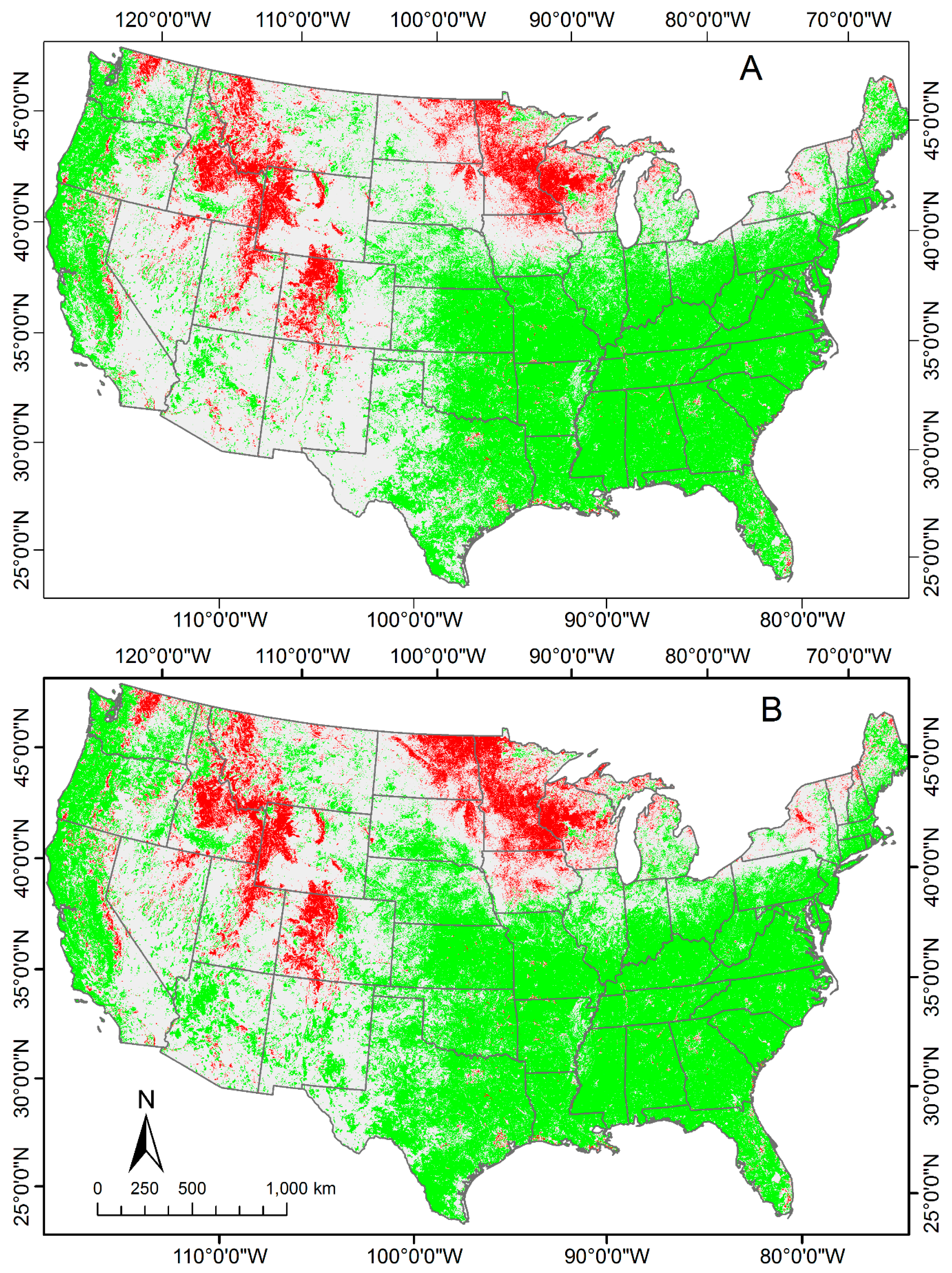
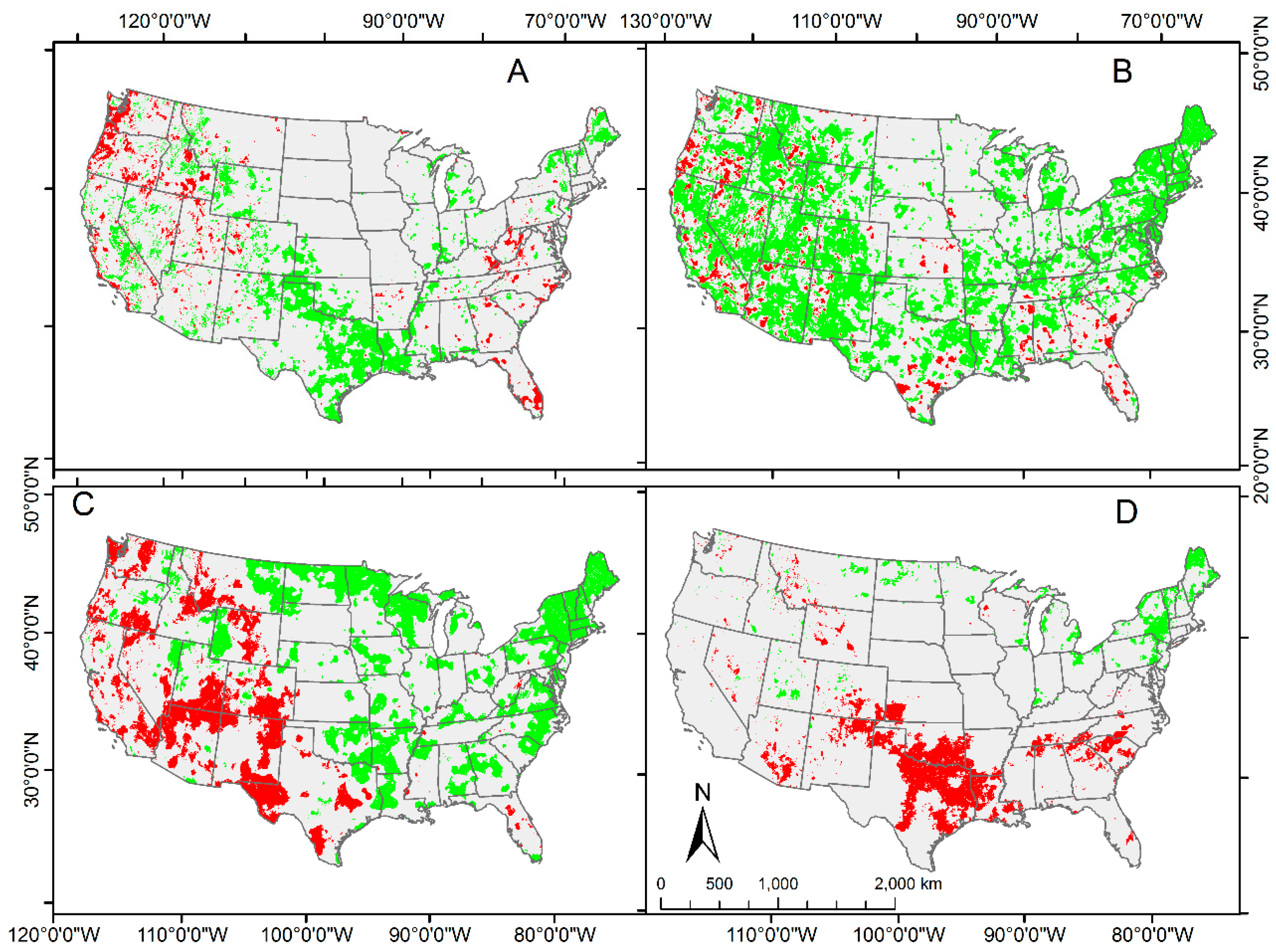
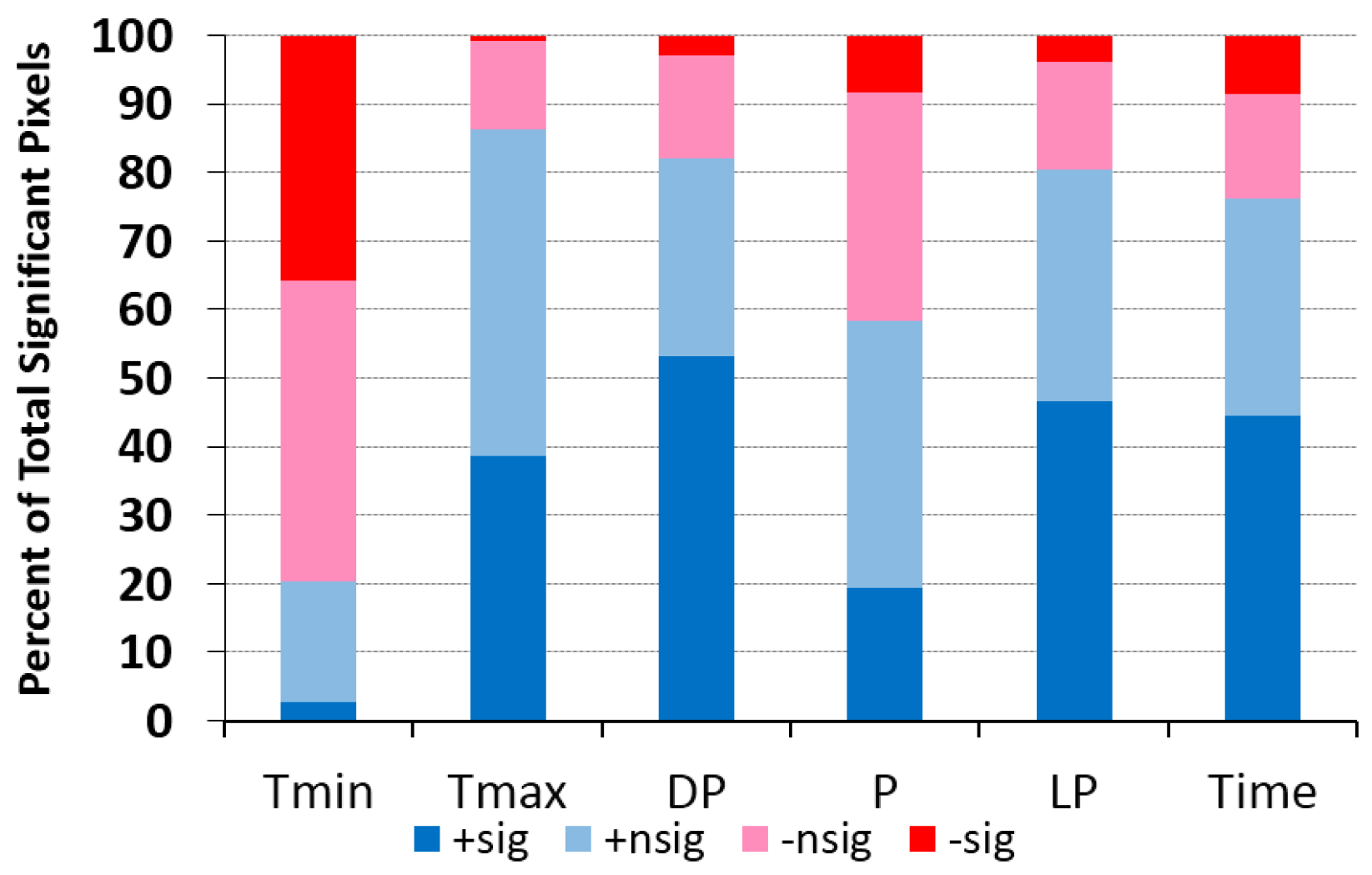
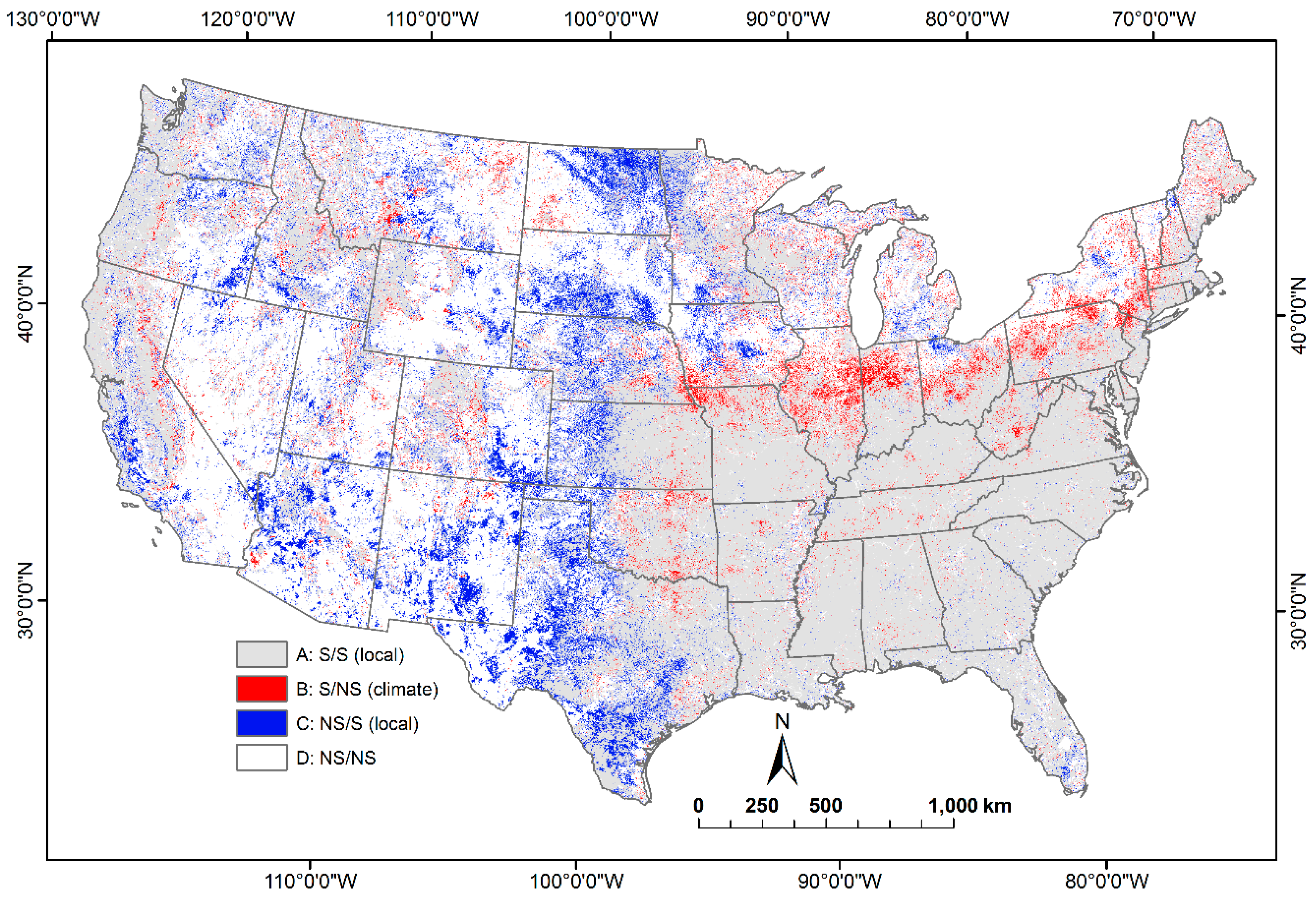
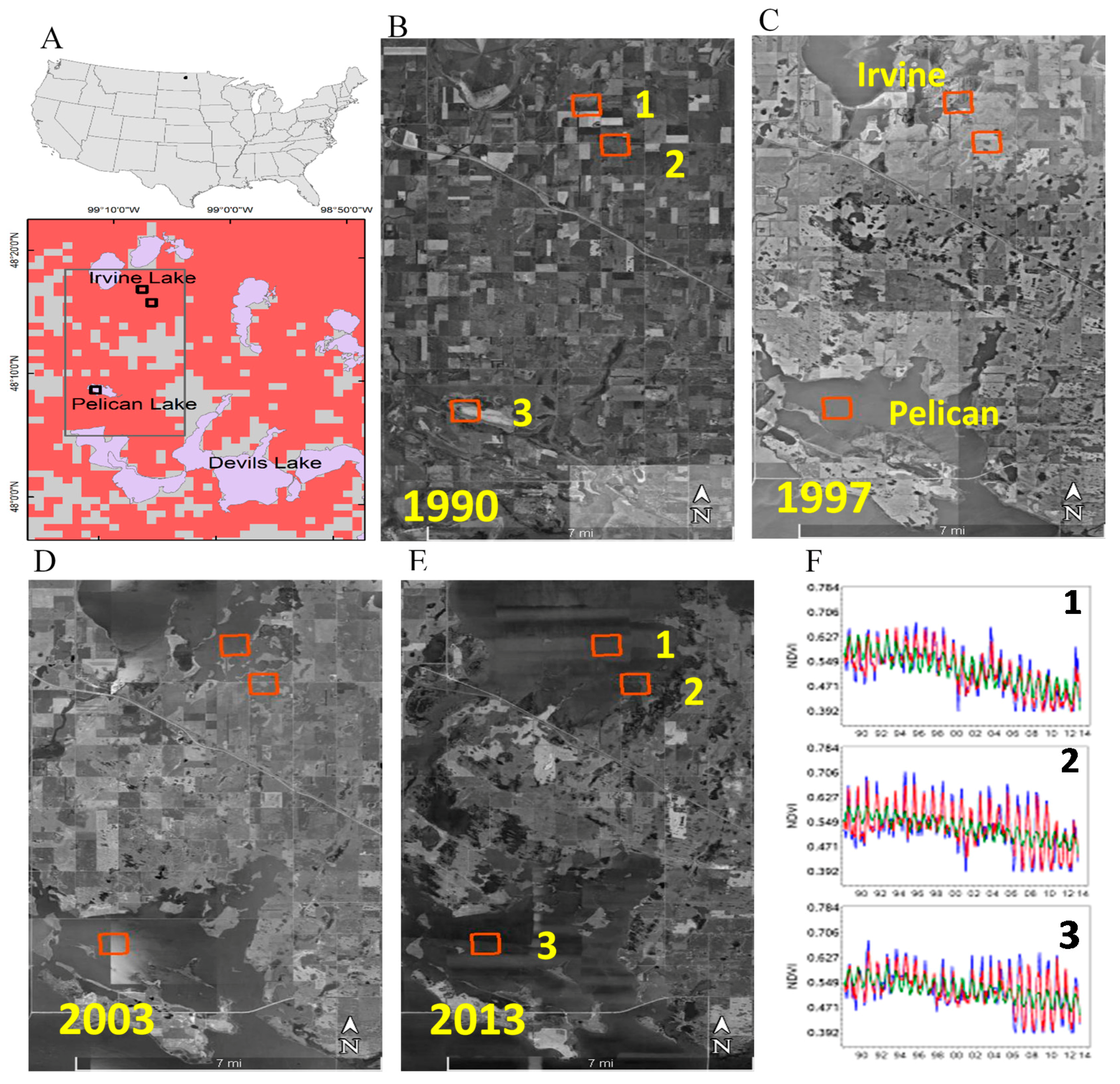


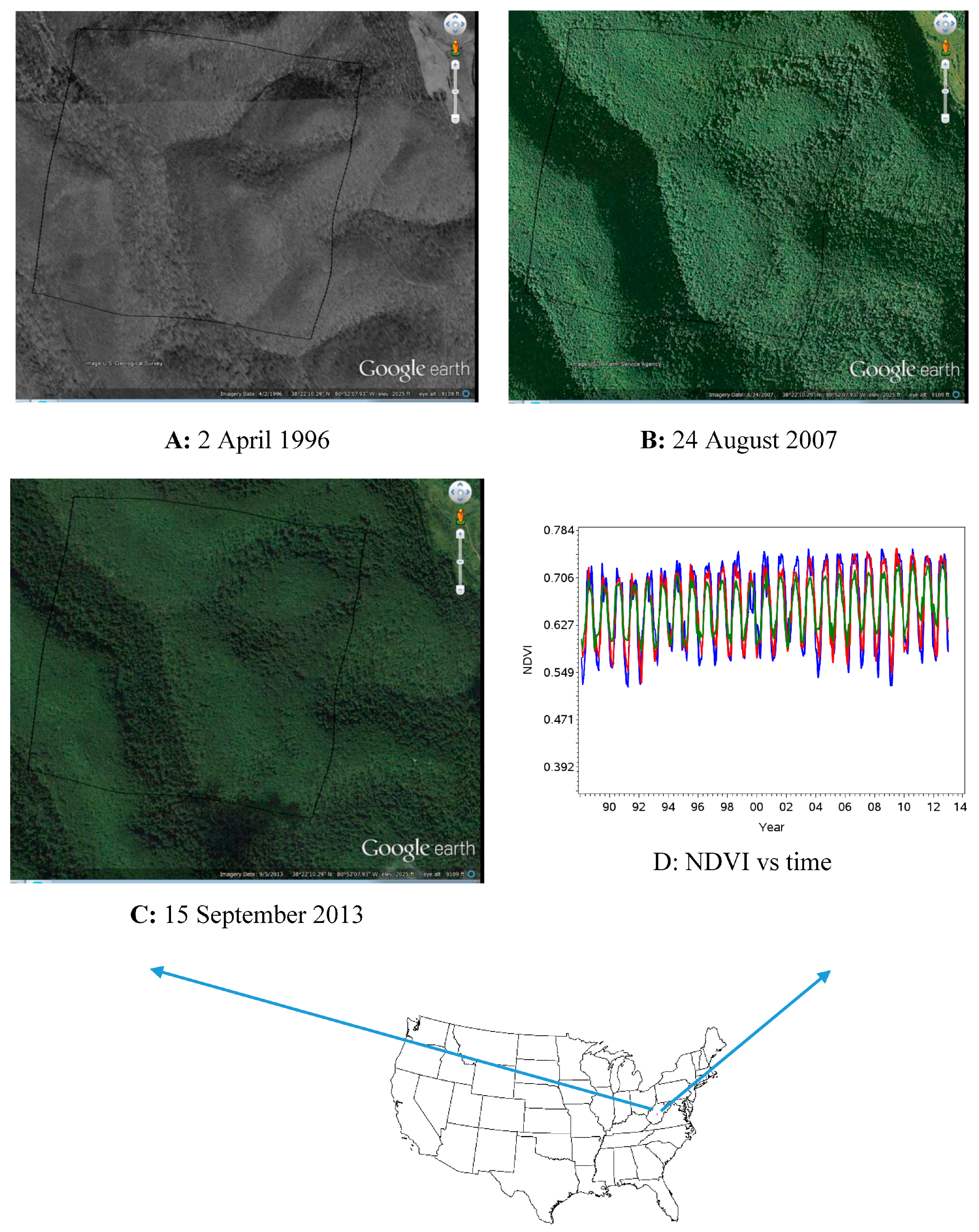
| Reference | Year | Location | Length | AVHRR Data | AVHRR Resolution | Climate Data Resolution | Independent Variables | Analysis |
|---|---|---|---|---|---|---|---|---|
| [32] | 2009 | Africa | 1982–1996 | GIMMS | 8-km | 0.5° | P | OLS |
| [33] | 2007 | Tibetan Plateau, China | 1982–1989 | GIMMS | 8-km | Station | P | LC |
| [34] | 2011 | China | 1982–2006 | GIMMS | 8-km | Station | T,P | OLS |
| [35] | 2009 | Brazil | 1981–2006 | GIMMS | 8-km | 0.5° | P | OLS |
| [36] | 2012 | Drylands, Global | 1981–2007 | GIMMS-g | 8-km | 2.5° | T,P,E | MK, OLS |
| [37] | 2005 | Sahel, Africa | 1982–2003 | GIMMS | 8-km | 2.5° | P | OLS |
| [38] | 2002 | Global | 1982–1990 | PAL | 8-km | 0.5° | T,P | OLS |
| [39] | 2004 | USA | 1989–1993 | EROS | 1-km | Station | T,P,PET, E | DW, spR |
| [40] | 2010 | USA and Canada | 1981–2001 | PAL | 8-km | 0.25°, 32-km | T,P,LST,E,S | OLS |
| [41] | 2012 | Canada | 1985–2007 | PAL | 1-km | Station | T, P | MK, OLS |
| [42] | 2012 | China | 1982–2003 | GIMMS | 8-km | Station | T, P | OLS |
| [43] | 2012 | Mexico | 1982–2007 | GIMMS | 8-km | Station | P | MK, HR, visual |
| [44] | 2005 | Sahel, Africa | 1982–1999 | PAL | 8-km | 2.5° | P | visual |
| [45] | 2010 | Asia | 1982–2006 | GIMMS | 8-km | 2.5° | T, P | EOF, SVD |
| [46] | 2012 | China | 1982–2012 | GIMMS | 8-km | 0.1° | T, P | OLS |
| [47] | 2009 | Brazil | 1982–2006 | GIMMS | 8-km | 0.1° | P | visual |
| [48] | 2004 | USA | 1990–2000 | EROS | 1-km | Station | SOI, P | visual |
| [49] | 2010 | USA | 1982–2007 | GVIx | 4-km | 32 km2 | DSL, P | OLS |
| [50] | 2008 | S. America | 1981–2000 | GIMMS | 8-km | - | Water level | visual |
| Variable | Increase | Decrease | Total |
|---|---|---|---|
| NDVI | 41.11 | 7.28 | 48.38 |
| Minimum Temperature | 35.41 | 4.09 | 39.50 |
| Maximum Temperature | 11.94 | 4.45 | 16.39 |
| Dew Point | 20.08 | 12.52 | 32.60 |
| Precipitation | 2.88 | 8.74 | 11.62 |
| NDVI Trends in Univariate Analysis | NDVI Trends in Multivariate Analyses | ||
|---|---|---|---|
| Significant | Not Significant | Total | |
| Significant | Outcome A | Outcome B | |
| 44.83 | 3.56 | 48.38 | |
| Not Significant | Outcome C | Outcome D | |
| 8.16 | 43.45 | 51.62 | |
| Total | 52.99 | 47.01 | 100.00 |
© 2017 by the authors. Licensee MDPI, Basel, Switzerland. This article is an open access article distributed under the terms and conditions of the Creative Commons Attribution (CC BY) license ( http://creativecommons.org/licenses/by/4.0/).
Share and Cite
Nash, M.S.; Wickham, J.; Christensen, J.; Wade, T. Changes in Landscape Greenness and Climatic Factors over 25 Years (1989–2013) in the USA. Remote Sens. 2017, 9, 295. https://doi.org/10.3390/rs9030295
Nash MS, Wickham J, Christensen J, Wade T. Changes in Landscape Greenness and Climatic Factors over 25 Years (1989–2013) in the USA. Remote Sensing. 2017; 9(3):295. https://doi.org/10.3390/rs9030295
Chicago/Turabian StyleNash, Maliha S., James Wickham, Jay Christensen, and Timothy Wade. 2017. "Changes in Landscape Greenness and Climatic Factors over 25 Years (1989–2013) in the USA" Remote Sensing 9, no. 3: 295. https://doi.org/10.3390/rs9030295




